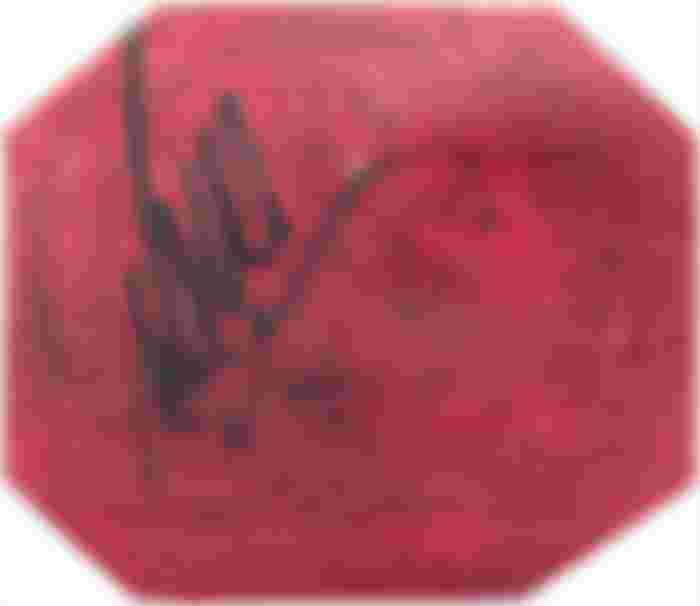The One-Cent Magenta
This faded, nearly-illegible stamp is in fact the marvellous 1856 British Guiana 1 cent Black-on-Magenta stamp, known among stamp collectors simply as "the 1c Magenta" or "the Magenta Stamp". It is truly unique; only one specimen is known to exist. It has belonged to many of the world's most famous stamp collectors, and has an almost mythic status in the stamp collector community.

Entire books have been written on this stamp, and James Barron 2017 book is especially captivating. Recently, the stamp was sold to Stanley Gibbons for $8.3 million. While insanely high for something that used to cost a penny, it was actually lower than pre-auction estimates. Stanley Gibbons is perhaps the most famous auction house and dealer of rare stamps.
There has developed a custom where the new owner of the One-Cent Magenta writes his signature on the back of the stamp. This is done in a manner which doesn't hurt the stamp, of course. Presumably, someone from Stanley Gibbons will continue this venerable tradition. But the question arises: who exactly own the One-Cent Magenta?

"To democratise the ownership"
Stanley Gibbons have said that they want "to democratise the ownership of this unique item" and "offer fractional ownership of the rarest and most valuable stamp in the world." They probably will not let us all write our initials on the back.
This stamp has belonged to both famous stamp collectors and millionaires. And now, Stanley Gibbons want to offer us all the opportunity to own a piece of history. This could, of course, be one giant marketing ploy. Sort of how you can buy the naming rights to a star. A fun gag gift, with no real-world consequences.
However, there is a sense that Stanley Gibbons want to give the stamp back to the community. Right now, we do not know what this will look like. But it got me thinking about ownership of rare items in general. What does it mean to own art? And can ownership truly be democratised? Can you truly own something if you do not own the whole part of it?
NFT's and art ownership
There has been a lot written about NFT's - non-fungible tokens - in the media, but I do think most misunderstand the very nature of the NFT. In most discussions, an NFT is framed as a deed or proof of ownership of a particular artwork, either physical or digital. But this is not exclusive ownership - especially if it's a digital asset. NFT's are better understood as patronage of the art. But this is nothing new.
Traditionally, art was not enjoyed alone. In medieval times, noblemen and kings would spend millions (in modern Dollars) building churches and cathedral and decorate them with art. Churches, which, once the final stone had been chiseled, became fully open to the public. The king and the nobleman got the clout and prestige of having built the thing. But come Sunday morning, both the king, nobleman, the baker, and the serf enjoyed the building and its art in the same way - in attending Holy Mass. In that moment, who truly owned the church - the king, the priest, or everyone?
Buying an NFT, therefore, doesn't make you the sole owner and lord of a particular piece of art. It makes you the patron, a man or woman who supports the artist and it gives you the bragging rights of saying so. It's non-selfish ownership, and in a sense philantropic. It is art not for the money, but for the art itself.
Philantropic philately?
But back to stamps. It Stanley Gibbons wanted to be innovative, and truly understood the technology, they could realise this democratic ownership in different ways. For example, NFT's representing patronage of this stamp and bragging rights in the stamp collector community. I would gladly pay $100 or $200 or even more for the once-in-a-lifetime of being involved with the Magenta Stamp in any meaningful way.
Or they could even make their own crypto currency, with each token representing a share. Introducing: StampCoin™, where each token is backed by one-millionth of the Magenta Stamp. Similar to PAXG, but the whole currency is backed by a sinlge stamp instead of ounces of gold. Super tacky, highly impractical, and tokens would be irredeemable, I know. I'm just having fun.
At the end of the day, Stanley Gibbons will still control the fate of the stamp: where to store it, when to sell it etc., no matter how much they democratise it. However, I do think this is a breath of fresh air.
My experience is that there is a division in the philatelic community. On the one side, you have the older generation in the stamp clubs, with their invaluable knowledge and mastery of the craft. And on the other side, you have lots of young people online, sharing stamps, making stamp art and being creative in ways unimaginable. We need both. And perhaps none other than the Magenta Stamp can make that happen.


Interesting first article here. I always appreciate learning something new, and I did not know about this stamp before. Welcome to read.cash.